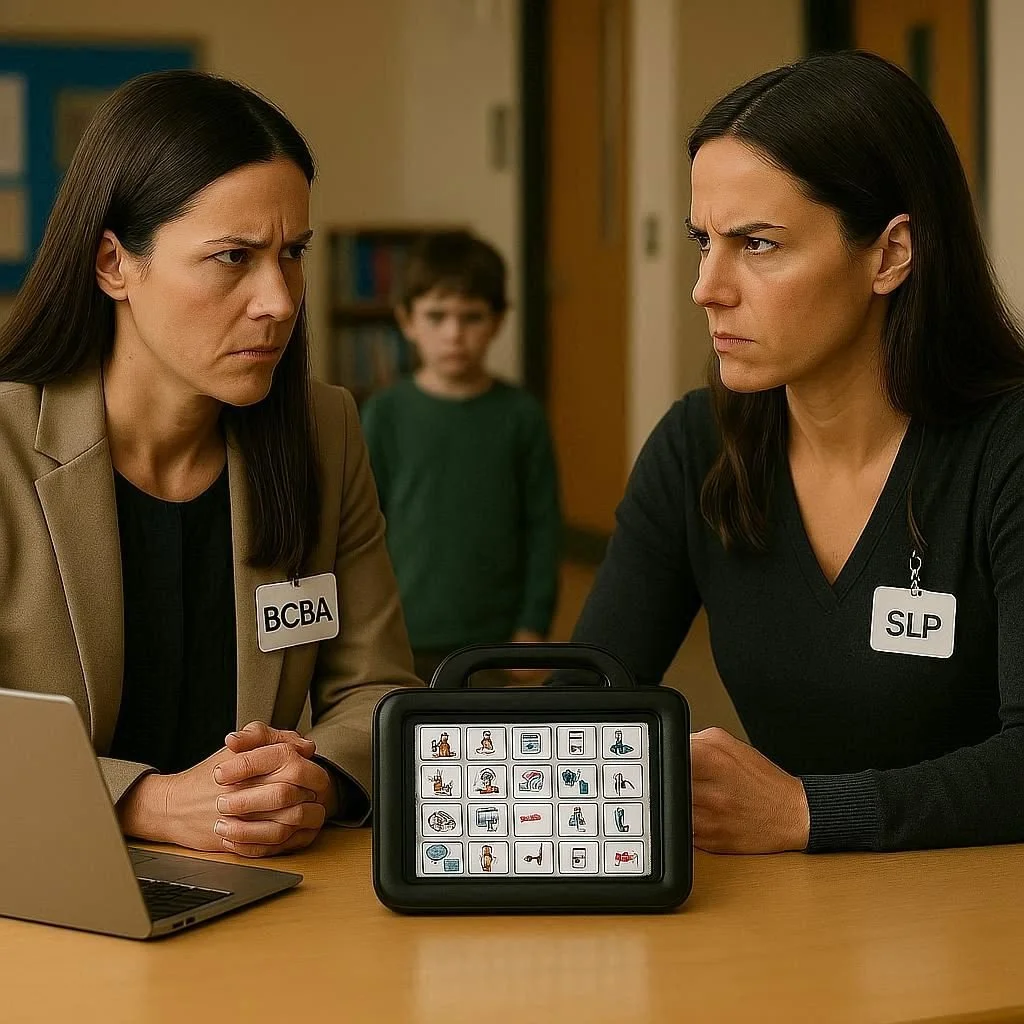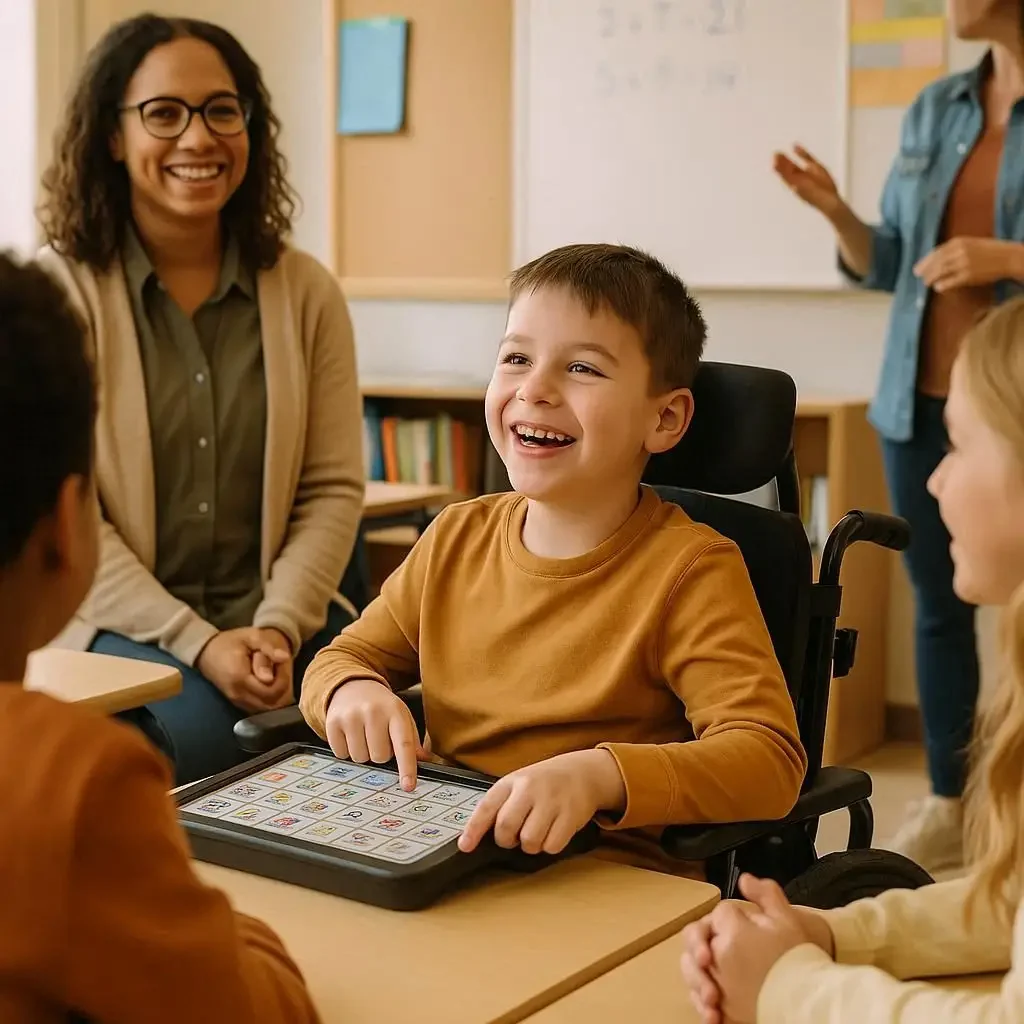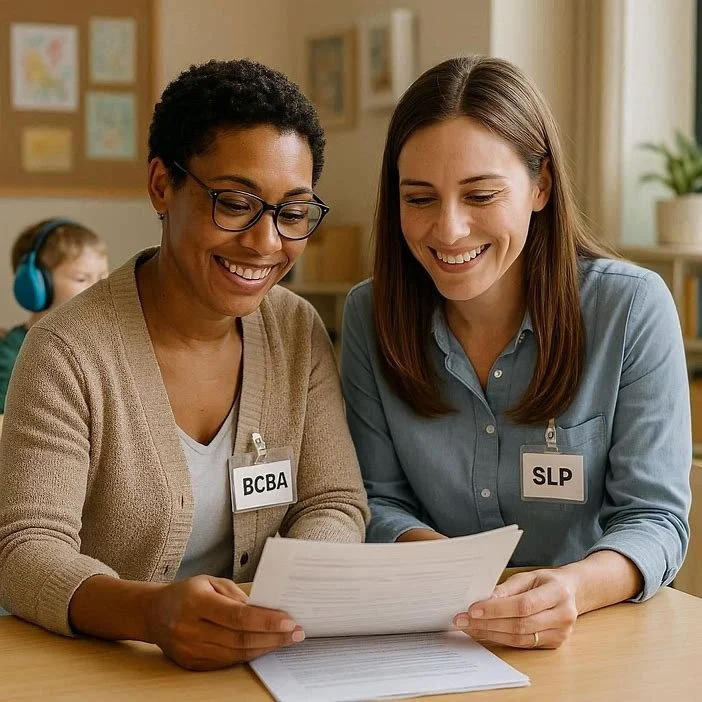The BCBA & SLP Collaborative Playbook (Pt. 1)
Unmuted: Scroll Wars - SLP vs. BCBA on Speech Generating Devices (SGDs)
1. Opening Huddle: The Case of SGD Scrolling
"Cheez-it, Cheez-it, Cheez-it, yogurt, ice cream sandwich, Cheez-it, Cheez-it." Ring any bells?
For many students using speech generating devices (SGDs), the list of repeated or random selections can look a lot like this. SGD use is a hot topic in SLP & BCBA collaboration, especially when a student spends more time scrolling, exploring, or stimming than communicating with intent. In this first post of our series, Kara and I explore both perspectives, showing how collaboration between SLPs and BCBAs can turn these moments into meaningful communication and functional outcomes.
To My BCBA Friends: Please reference Figure 1 (“A decision-making model for assessing nonbehavioral treatments”) in Brodhead’s 2015 article.
2. SLP’s Call: Curiosity as Communication
Scrolling is not only a natural developmental stage but also a multifunctional behavior. A blend of exploration, sensory regulation, and early communicative practice. Repetitive AAC selection can represent a child’s attempt to regulate their nervous system, explore symbol-meaning relationships, or rehearse motor plans necessary for efficient device use.
Repetition within AAC systems can facilitate motor learning and symbol mapping, supporting later automaticity and intentional communication (Murray & Goldbart, 2011; Sennott, Light, & McNaughton, 2016). When clinicians frame scrolling as part of language exploration rather than a behavior to reduce, we open space for authentic growth.
In neurodiversity-affirming practice, stimming is recognized as self-regulation, not pathology. Similarly, scrolling should be interpreted through curiosity and context. We can ask, “What is the communicator telling us through this repetition? Rather than..”How do we stop it?” This shift supports autonomy and aligns with the ethical principle of presuming competence (ASHA, n.d.).
When adjustments are necessary, they should aim to support regulation and minimize distraction without limiting access. Such as offering movement breaks, co-regulation strategies, or modifying dwell-time settings. Interdisciplinary collaboration among SLPs, BCBAs, and educators ensures that interventions respect both communication and regulation needs while keeping the AAC user’s voice always available.
3. BCBA’s Call: Function as Foundation
There are several relevant angles for behavior analysts in relation to stimming or repetitive “scrolling/tapping” on an AAC (augmentative and alternative communication) device. First is the general research around the use of AAC technology, and second are the applied issues clinicians or those supporting clients in teaching AAC might encounter. A common complaint is that a client’s perseveration on words or buttons is “becoming a distraction” or “does not teach functional use of the device.” In response, teachers and practitioners sometimes redirect the user, prompt more functional responses, or (in severe cases) remove access to the device.
The behavior-analytic literature on verbal development may be relevant here. Greer and colleagues describe early, foundational listener and observing cusps as important developmental steps that support later speaker behavior (Greer & Ross, 2008; Greer, 2011). This process is somewhat comparable to an early learners “parroting” (ex. repetitively saying “mama, mama”). From that perspective, repetitive engagement with an AAC device could represent an early stage of exploration or a developing listener/observing repertoire, rather than solely nonfunctional perseveration.
However, research specifically addressing AAC-related stereotypy and its relation to verbal behavior development are limited. Only a small number of function-based studies have examined repetitive AAC use. For example, Andzik et al. (2024) found that AAC-related stereotypy did not appear to interfere with learning for their participants and recommended that practitioners assess the degree of interference before intervening. Similarly, Kaneda and Sasaki (2025) described an individual who engaged in repetitive tapping likely maintained by sensory feedback, and another participant whose unclear association between icons and their meaning may have contributed to low rates of vocal requests (potentially supporting arguments that nonfunctional device use could influence learning outcomes). Overall, we simply do not know enough to make any conclusions, which emphasizes the importance approaching this topic with an open mind.
4. The Game Plan: Finding Our Shared Strategy
From the BCBA: AAC device usage is, first and foremost, not my area of expertise. This means a few things. If I have a client who engages in frequent scrolling on their device, my approach needs to be individualized, and I should seek guidance from BCBAs experienced in this area while collaborating with SLPs knowledgeable about SGD usage. Given the limited research in this area, I want to echo the current recommendations: evaluate the level of interference scrolling has on (1) the verbal behavior development of the client, (2) their overall learning experience, and (3) the learning experience of others around them. I also want to echo Kara’s point that client rights should always be protected. While removing a device may seem “convenient” as a solution to excessive scrolling, this is not acceptable. A client’s device is their voice, and to quote Kara, “you can’t rip out a client’s voicebox”. An AAC device should be treated with the same level of respect.
From the SLP: In a perfect world, the solution would be to let them explore freely without restriction. But we know classrooms and group settings bring unique challenges. Other children may be distracted or drawn in by the device. In those cases, the first step can be gentle redirection. If that doesn’t work, we’d respond the same way we would with a child vocalizing disruptively: by offering a quiet corner, calm-down strategy, or other regulation support. Only if those steps don’t work, and it truly disrupts the environment, would we consider a technical adjustment such as changing dwell time settings on the device. This reduces immediate auditory or visual feedback, making it less likely to be purely sensory-seeking, while still keeping the child’s voice available.
The key is that removal of the device is never the solution. Exploration should be protected as part of learning, while supports and adjustments balance both the child’s needs and the classroom environment.
“An interdisciplinary collaboration for individuals with ASD involves combining the strengths of multiple disciplines in order to maximize client outcomes.”
Team Practice: A Mock Case Example
Case Example: Alex is a 7-year-old student who uses an AAC device to communicate at home and school. His teachers and therapists noticed that he often scrolls quickly through pages or taps the same buttons over and over, especially during transitions or noisy classroom times. Sometimes, adults worry that he’s “just playing” with the device instead of communicating.
Kara and I both recognize that these scenarios are often easier said than done, and that interdisciplinary collaboration can be quite challenging. Our goal is to emphasize the importance of putting the client first, listening openly to team members, and identifying solutions that maximize benefits for the child at all times.
To model this type of collaboration, we’ve created a mock case scenario that we hope our colleagues—BCBAs and SLPs alike—can use as a practical example for navigating professional discourse.
BCBA Perspective: Based on the teacher and SLP’s observations, the BCBA collected data on (1) the time of day in which scrolling occurred, (2) what the scrolling looked like topographically, (3) common consequences (or what occurred immediately after the behavior, how others responded, how Alex responded) and (4) other environment stimuli. These data supported that Alex began scrolling during transitions and when the volume level in the classroom increased. During transitions, it was also noted that the volume level increased in the hallways.
SLP Perspective: Before making changes, the team decided to take a closer look at what might be happening. The SLP noticed that Alex’s scrolling tended to increase when he seemed overstimulated or uncertain about what to do next. From this perspective, the scrolling looked more like exploration and self-regulation than off-task behavior. It helped him stay engaged and familiar with his device.
The Game Plan:
Working together, the SLP and BCBA developed a plan to support Alex’s regulation and communication without taking away his device.
They:
Kept full device access available at all times.
Added a “volume meter” visual to the classroom. When the volume exceeded a certain level, Alex was taught to ask for a sensory break and/or headphones.
Offered sensory or movement breaks during busy parts of the day.
Modeled language during scrolling moments (e.g., “You like that word—let’s see what comes next.”)
An accommodation was added to Alex’s plan where he would transition to activities early. During “quiet hallway times” the adult with Alex worked to follow Alex’s indicating responses to teach mands and tacts in the natural environment.
The BCBA arranged 15 minutes a week with Alex in a quiet area adjacent from the classroom to engage in structured teaching sessions for requesting, labeling, and responding to questions.
Made small technical adjustments like changing dwell-time settings to help reduce accidental re-tapping.
The Final Score? 🏆 BCBA: 1 🎯 SLP: 1 🌟 Alex: 100
After several weeks, Alex began using his device more purposefully and calmly, with fewer moments of frustration. Teachers found that when adults respected his need to explore, and programmed specific and meaningful times to practice device use, his participation in learning and social activities improved, scrolling decreased, and functional device use increased.
THANK YOU KARA!
A huge thank you to Kara for making this collaboration possible. To learn more about her, her team, and her mission, please read her bio below.
Kara Heckerman, M.S., CCC-SLP
Founder: Aligned Horizons (Therapy Without Limits
)
Kara Heckerman is a passionate and experienced speech-language pathologist dedicated to empowering individuals to achieve their full communication potential. With a Master of Science in Communication Disorders from The Florida State University and over 10 years of experience, she specializes in designing individualized therapy plans tailored to each person’s unique needs.
Kara’s journey in speech-language pathology is driven by the belief that every individual deserves the opportunity to communicate effectively and engage with the world confidently. As a neurodivergent-affirming practitioner, she is committed to integrating the latest evidence-based practices into therapy, ensuring the highest standard of care.
She values meaningful partnerships with families and caregivers. By equipping them with tools and knowledge, Kara strives to ensure success beyond therapy sessions. Her approach is warm, supportive, and client-centered, fostering an environment where growth and connection flourish. This reflects our mission of cultivating authentic relationships and meaningful progress.
Communication begins with connection. Let’s get aligned.
Resources
American Speech-Language-Hearing Association. (n.d.). Augmentative and alternative communication (AAC). ASHA Practice Portal. Retrieved October 20, 2025, from https://www.asha.org/practice-portal/professional-issues/augmentative-and-alternative-communication/
American Speech-Language-Hearing Association. (n.d.). Cultural and linguistic competence. ASHA Practice Portal. Retrieved October 20, 2025, from https://www.asha.org/practice-portal/professional-issues/cultural-competence/
Andzik, N. R., Walker, S. F., O’Hara, C. A., Camacho, S. A., Landmeier, L., & Brander, M. (2024). Preliminary assessment of augmentative and alternative communication-related stereotypy. Behavioral Interventions, 39(4), e2042. https://doi.org/10.1002/bin.2042
Brady, N. C., Bruce, S., Goldman, A., Erickson, K., Mineo, B., Ogletree, B. T., Paul, D., Romski, M. A., Sevcik, R. A., Siegel, E., Schoonover, J., & Wilkinson, K. M. (2016). Support for AAC use in individuals with intellectual and developmental disabilities. American Journal of Speech-Language Pathology, 25(4), 441–461. https://doi.org/10.1044/2016_AJSLP-15-0135
Cafiero, J. (2018). Meaningful use of AAC in autism: A guide for practitioners. Autism Asperger Publishing Company.
Greer, R. D., & Ross, D. E. (2008). Verbal behavior analysis: Inducing and expanding new verbal capabilities in children with language delays. Pearson.
Greer, R. D. (2011). Effects of conditioning voices as reinforcers for listener responding. Journal of Applied Behavior Analysis, 44(2), 337–342. https://doi.org/10.1901/jaba.2011.44-337
Greer, R.D., Dudek, J. & Chang, H. Observation, Language Learning, and Development: The Verbal Behavior Development Theory. Psychol Rec 74, 541–554 (2024). https://doi.org/10.1007/s40732-024-00585-1
Kaneda, M., & Sasaki, G. (2025). The relationship between the use of speech-generating devices and verbal requests in children with autism spectrum disorder and intellectual disabilities. Journal of Autism and Developmental Disorders. Advance online publication. https://doi.org/10.1007/s10803-025-06910-z
Koenig, K. P., & Williams, L. H. (2020). Neurodiversity-affirming supports and self-regulation. OT Practice.
Murray, J., & Goldbart, J. (2011). Augmentative and alternative communication: A developmental framework of communicative competence. Disability and Rehabilitation, 33(17–18), 1551–1560. https://doi.org/10.3109/09638288.2010.535090
Sennott, S. C., Light, J. C., & McNaughton, D. (2016). AAC modeling intervention research review. Augmentative and Alternative Communication, 32(2), 69–79. https://doi.org/10.3109/07434618.2016.1157398
*Disclaimer: The views expressed in this blog are my own (Functionally Speaking ABA) and do not reflect the views of UNMC




